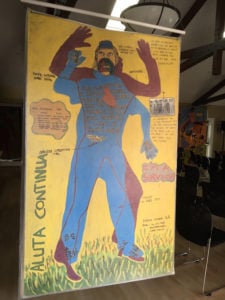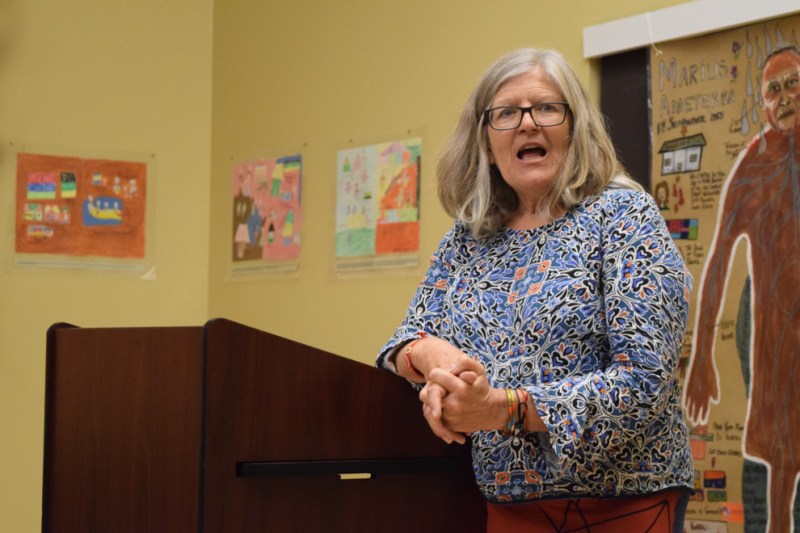A young woman whose brother fell silent after the bombing of a shopping center. A man who lost his twin brother in a police shooting. A mother who refused to believe that her child died in a catastrophic fire.
These are just some of the life stories that visitors can see on display at “Breaking the Silence: A Luta Continua,” an ongoing art project by the Human Rights Media Centre (HRMC). A handful of works from the project will be on display at the Black Community Services Center (BCSC) from 9 a.m. until 1 p.m. on Thursday.
Survivors of apartheid
On Tuesday night, about 40 students and visitors gathered in the BCSC to meet Shirley Gunn, founder and director of the HRMC, who delivered a keynote speech regarding the purpose of her exhibition.

“Transition from war to peace, conflict to peace, is very tricky. It has to be inclusive,” Gunn said. “Also, it’s not perfect. If you are taught that it is, you’re wrong.”
Gunn, an anti-apartheid activist, reflected on her many years spent fighting South Africa’s system of racial segregation as well as what has happened since.
“As a person who was part of the armed struggle, we didn’t consider our emotions, we didn’t consider our feelings,” Gunn said. “We were brave and we zipped up, and it’s 20 years later that we begin to talk about our lives as liberators and freedom fighters.”
But it is not the intent of “Breaking the Silence: A Luta Continua” to lionize freedom fighters such as Gunn. Instead, the exhibition serves as a way for the thousands of survivors of apartheid to communicate their experiences through art. Most of the works on display are “bodymaps,” life-sized drawings in which the artist traces their figure and visualizes their memories of apartheid.
Take Emily Phapiso, who Gunn described as the “anchor” of her family. She became a mother at the age of 16 in 2003, but she had been caring for her brother seven years prior to that, when he stopped speaking after being injured in a bomb blast at Christmastime. Fittingly, her bodymap bears the image of an anchor. Then there’s Gordon Mali, whose twin was killed by police in the Trojan Horse Massacre in 1985. Gunn said that Gordon attributed much of his bad fortune later in life — the death of his sister, losing his leg in an accident — to the fact that his twin was never given a proper funeral according to Xhosa culture.
Though it was only known as “apartheid” from 1948 to 1994, racial segregation had been a part of South Africa for centuries — and its effects continue to be seen today.
“This is a very hard reality for some of us who put our lives on the line for our freedom,” Gunn said.
South African history as a textbook
In an interview following her speech, Gunn elaborated on what drove her to join the fight against apartheid and why her work is still relevant today.
“You lose friends, you lose family, but you gain a hell of a lot — you gain another family, another community, another global community on top of that,” she said of her decision to become an activist.
She first conceived of “Breaking the Silence: A Luta Continua” in 2002, as the HRMC was filming a documentary named “We Never Give Up” in which members of the Khulumani Support Group were interviewed about their experiences under apartheid. Khulumani is a Zulu word which means “to speak out.”
Since the project’s inception, Gunn says that thousands of survivors have participated, creating bodymaps, scrapbooks and other forms of art. The exhibit has been featured in the Holocaust Center and the Slave Lodge in Cape Town as well as the Apartheid Museum in Johannesburg. The exhibition at Stanford is its first trip to the United States.
Ramah Awad ’17 and Rachel Samuels ’17, who both went abroad in Cape Town last winter, were assigned to work with the HRMC as a part of their studies. After receiving approval from Stanford, they took a week out of their quarter to accompany Gunn to the town of Worcester and the township of Zwelethemba, where they helped survivors create their own bodymaps. Though the legislative end of apartheid in 1994 saw the creation of the Truth and Reconciliation Commission, which aimed to help transition the country to democracy and equality, Gunn said that the poverty of the individuals she works with is a reminder of the commission’s shortcomings.
“The majority of people on the bottom end of the pyramid are poor and black,” Gunn said. “Nothing has changed for them. They make a mark on their vote, and they might have a flushing toilet … Legislatively, [apartheid] has been repealed, but it exists.”
“A lot of [Gunn’s] work has to deal with reparations that haven’t been given yet,” Awad said, elaborating on the title of the exhibit. “A Luta Continua,” Portuguese for “the struggle continues,” has become a global political slogan of sorts. “That’s what I think of when I hear ‘the struggle continues’ — I think about the work that has yet to continue in terms of reparations.”
Following their return to campus, Awad and Samuels reached out to the Center for African Studies and the Institute for Diversity in the Arts in the hopes of exposing Gunn’s work to a wider audience.
“I think it brings to life the fact that South Africa is not, in fact, the beacon of democracy and transition that we learn it is in so many of our courses,” Samuels said. “South African history was a textbook before. It was a lecture before. We can interact with it. It’s obviously real for so many more people, and now it can be real for all of those students who are living thousands of miles away, here.”
Contact Jacob Nierenberg at jhn2017 ‘at’ stanford.edu.
